2017 NISSAN VERSA NOTE child restraint
[x] Cancel search: child restraintPage 69 of 414
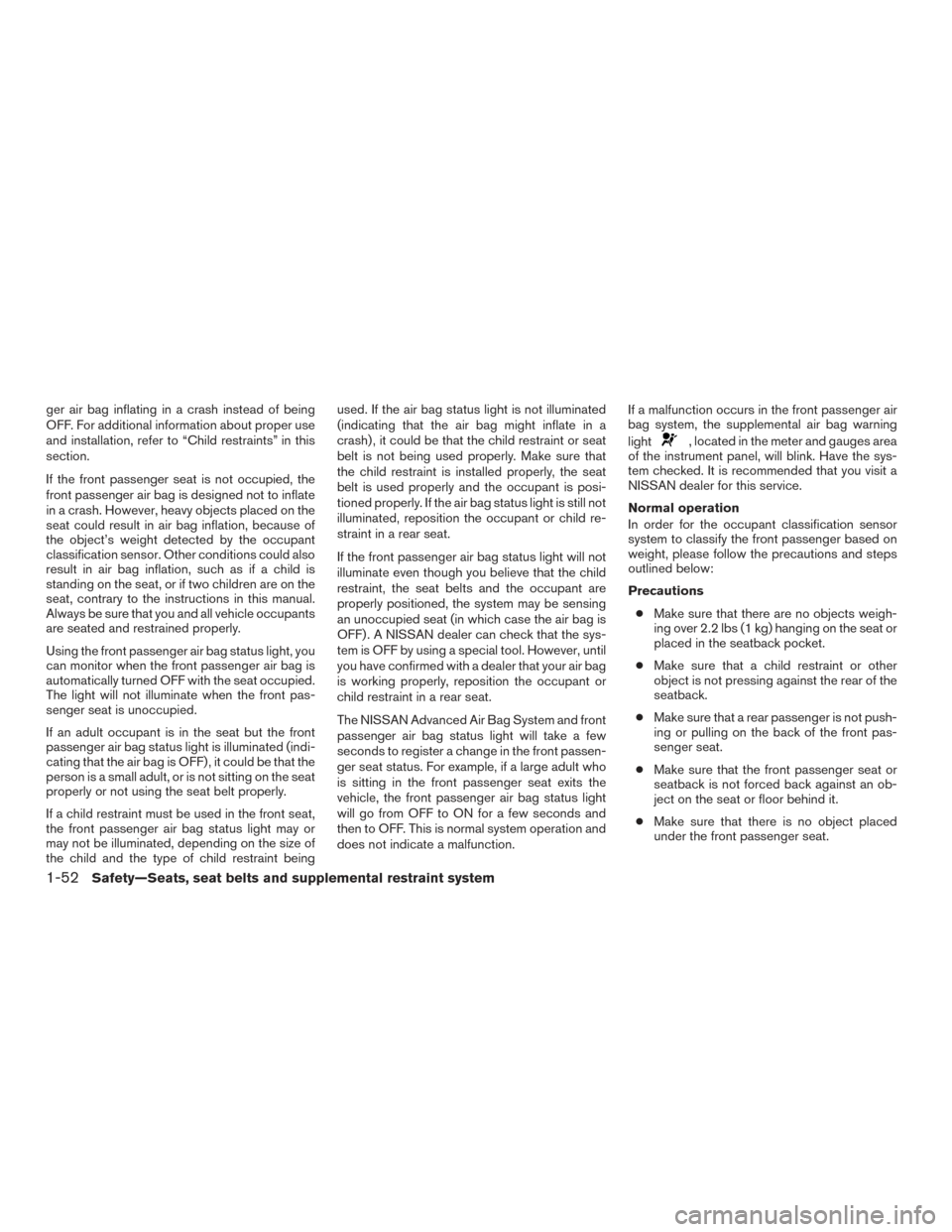
ger air bag inflating in a crash instead of being
OFF. For additional information about proper use
and installation, refer to “Child restraints” in this
section.
If the front passenger seat is not occupied, the
front passenger air bag is designed not to inflate
in a crash. However, heavy objects placed on the
seat could result in air bag inflation, because of
the object’s weight detected by the occupant
classification sensor. Other conditions could also
result in air bag inflation, such as if a child is
standing on the seat, or if two children are on the
seat, contrary to the instructions in this manual.
Always be sure that you and all vehicle occupants
are seated and restrained properly.
Using the front passenger air bag status light, you
can monitor when the front passenger air bag is
automatically turned OFF with the seat occupied.
The light will not illuminate when the front pas-
senger seat is unoccupied.
If an adult occupant is in the seat but the front
passenger air bag status light is illuminated (indi-
cating that the air bag is OFF) , it could be that the
person is a small adult, or is not sitting on the seat
properly or not using the seat belt properly.
If a child restraint must be used in the front seat,
the front passenger air bag status light may or
may not be illuminated, depending on the size of
the child and the type of child restraint beingused. If the air bag status light is not illuminated
(indicating that the air bag might inflate in a
crash) , it could be that the child restraint or seat
belt is not being used properly. Make sure that
the child restraint is installed properly, the seat
belt is used properly and the occupant is posi-
tioned properly. If the air bag status light is still not
illuminated, reposition the occupant or child re-
straint in a rear seat.
If the front passenger air bag status light will not
illuminate even though you believe that the child
restraint, the seat belts and the occupant are
properly positioned, the system may be sensing
an unoccupied seat (in which case the air bag is
OFF) . A NISSAN dealer can check that the sys-
tem is OFF by using a special tool. However, until
you have confirmed with a dealer that your air bag
is working properly, reposition the occupant or
child restraint in a rear seat.
The NISSAN Advanced Air Bag System and front
passenger air bag status light will take a few
seconds to register a change in the front passen-
ger seat status. For example, if a large adult who
is sitting in the front passenger seat exits the
vehicle, the front passenger air bag status light
will go from OFF to ON for a few seconds and
then to OFF. This is normal system operation and
does not indicate a malfunction.
If a malfunction occurs in the front passenger air
bag system, the supplemental air bag warning
light
, located in the meter and gauges area
of the instrument panel, will blink. Have the sys-
tem checked. It is recommended that you visit a
NISSAN dealer for this service.
Normal operation
In order for the occupant classification sensor
system to classify the front passenger based on
weight, please follow the precautions and steps
outlined below:
Precautions
● Make sure that there are no objects weigh-
ing over 2.2 lbs (1 kg) hanging on the seat or
placed in the seatback pocket.
● Make sure that a child restraint or other
object is not pressing against the rear of the
seatback.
● Make sure that a rear passenger is not push-
ing or pulling on the back of the front pas-
senger seat.
● Make sure that the front passenger seat or
seatback is not forced back against an ob-
ject on the seat or floor behind it.
● Make sure that there is no object placed
under the front passenger seat.
1-52Safety—Seats, seat belts and supplemental restraint system
Page 70 of 414
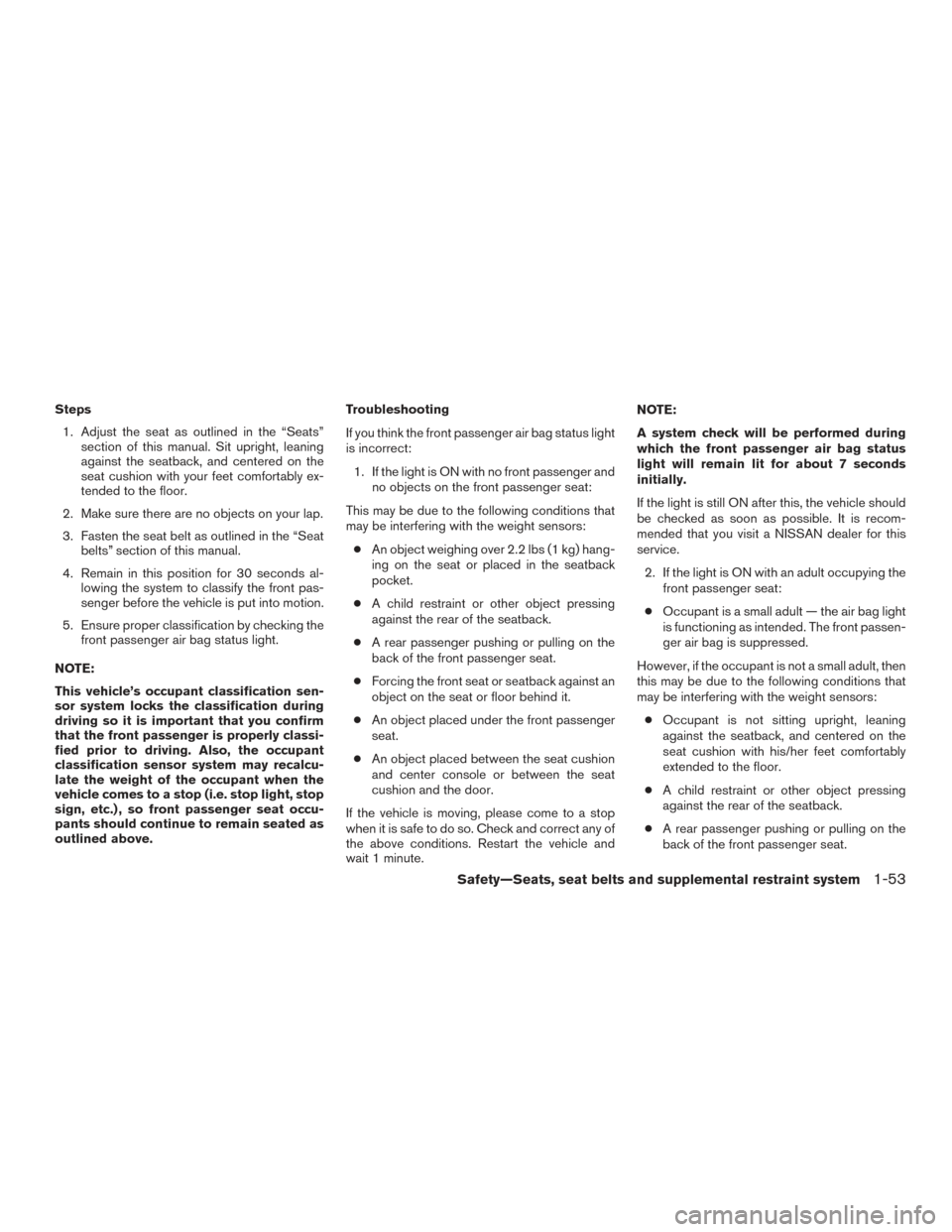
Steps1. Adjust the seat as outlined in the “Seats” section of this manual. Sit upright, leaning
against the seatback, and centered on the
seat cushion with your feet comfortably ex-
tended to the floor.
2. Make sure there are no objects on your lap.
3. Fasten the seat belt as outlined in the “Seat belts” section of this manual.
4. Remain in this position for 30 seconds al- lowing the system to classify the front pas-
senger before the vehicle is put into motion.
5. Ensure proper classification by checking the front passenger air bag status light.
NOTE:
This vehicle’s occupant classification sen-
sor system locks the classification during
driving so it is important that you confirm
that the front passenger is properly classi-
fied prior to driving. Also, the occupant
classification sensor system may recalcu-
late the weight of the occupant when the
vehicle comes to a stop (i.e. stop light, stop
sign, etc.) , so front passenger seat occu-
pants should continue to remain seated as
outlined above. Troubleshooting
If you think the front passenger air bag status light
is incorrect:
1. If the light is ON with no front passenger and no objects on the front passenger seat:
This may be due to the following conditions that
may be interfering with the weight sensors: ● An object weighing over 2.2 lbs (1 kg) hang-
ing on the seat or placed in the seatback
pocket.
● A child restraint or other object pressing
against the rear of the seatback.
● A rear passenger pushing or pulling on the
back of the front passenger seat.
● Forcing the front seat or seatback against an
object on the seat or floor behind it.
● An object placed under the front passenger
seat.
● An object placed between the seat cushion
and center console or between the seat
cushion and the door.
If the vehicle is moving, please come to a stop
when it is safe to do so. Check and correct any of
the above conditions. Restart the vehicle and
wait 1 minute. NOTE:
A system check will be performed during
which the front passenger air bag status
light will remain lit for about 7 seconds
initially.
If the light is still ON after this, the vehicle should
be checked as soon as possible. It is recom-
mended that you visit a NISSAN dealer for this
service.
2. If the light is ON with an adult occupying the front passenger seat:
● Occupant is a small adult — the air bag light
is functioning as intended. The front passen-
ger air bag is suppressed.
However, if the occupant is not a small adult, then
this may be due to the following conditions that
may be interfering with the weight sensors: ● Occupant is not sitting upright, leaning
against the seatback, and centered on the
seat cushion with his/her feet comfortably
extended to the floor.
● A child restraint or other object pressing
against the rear of the seatback.
● A rear passenger pushing or pulling on the
back of the front passenger seat.
Safety—Seats, seat belts and supplemental restraint system1-53
Page 71 of 414

●Forcing the front seat or seatback against an
object on the seat or floor behind it.
● An object placed under the front passenger
seat.
● An object placed between the seat cushion
and center console or between the seat
cushion and the door.
If the vehicle is moving, please come to a stop
when it is safe to do so. Check and correct any of
the above conditions. Restart the vehicle and
wait 1 minute.
NOTE:
A system check will be performed during
which the front passenger air bag status
light will remain lit for about 7 seconds
initially.
If the light is still ON after this, the person should
be advised not to ride in the front passenger seat
and the vehicle should be checked as soon as
possible. It is recommended that you visit a
NISSAN dealer for this service. 3. If the light is OFF with a small adult, child or child restraint occupying the front passen-
ger seat. This may be due to the following conditions
that may be interfering with the weight sen-
sors:
● Small adult or child is not sitting upright,
leaning against the seatback, and centered
on the seat cushion with his/her feet com-
fortably extended to the floor.
● The child restraint is not properly installed,
as outlined in the “Child restraints” section of
this manual.
● An object weighing over 2.2 lbs (1 kg) hang-
ing on the seat or placed in the seatback
pocket.
● A child restraint or other object pressing
against the rear of the seatback.
● A rear passenger pushing or pulling on the
back of the front passenger seat.
● Forcing the front seat or seatback against an
object on the seat or floor behind it.
● An object placed under the front passenger
seat.
● An object placed between the seat cushion
and center console. If the vehicle is moving, please come to a stop
when it is safe to do so. Check and correct any of
the above conditions. Restart the vehicle and
wait 1 minute.
NOTE:
A system check will be performed during
which the front passenger air bag status
light will remain lit for about 7 seconds
initially.
If the light is still OFF after this, the small adult,
child or child restraint should be repositioned in
the rear seat and the vehicle should be checked
as soon as possible. It is recommended that you
visit a NISSAN dealer for this service.
Other supplemental front-impact air bag
precautions
WARNING
●
Do not place any objects on the steering
wheel pad or on the instrument panel.
Also, do not place any objects between
any occupant and the steering wheel or
instrument panel. Such objects may be-
come dangerous projectiles and cause
injury if the front air bags inflate.
1-54Safety—Seats, seat belts and supplemental restraint system
Page 75 of 414
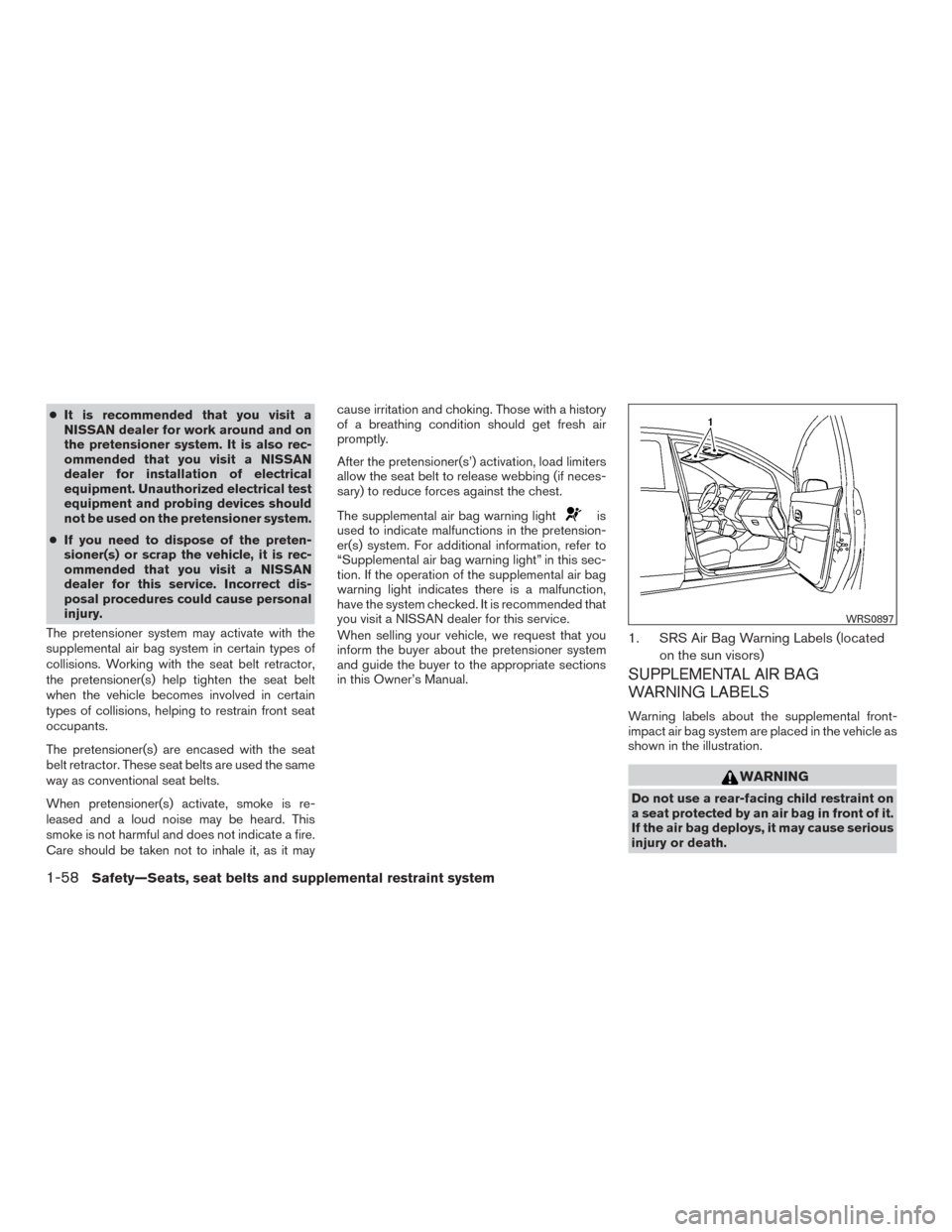
●It is recommended that you visit a
NISSAN dealer for work around and on
the pretensioner system. It is also rec-
ommended that you visit a NISSAN
dealer for installation of electrical
equipment. Unauthorized electrical test
equipment and probing devices should
not be used on the pretensioner system.
● If you need to dispose of the preten-
sioner(s) or scrap the vehicle, it is rec-
ommended that you visit a NISSAN
dealer for this service. Incorrect dis-
posal procedures could cause personal
injury.
The pretensioner system may activate with the
supplemental air bag system in certain types of
collisions. Working with the seat belt retractor,
the pretensioner(s) help tighten the seat belt
when the vehicle becomes involved in certain
types of collisions, helping to restrain front seat
occupants.
The pretensioner(s) are encased with the seat
belt retractor. These seat belts are used the same
way as conventional seat belts.
When pretensioner(s) activate, smoke is re-
leased and a loud noise may be heard. This
smoke is not harmful and does not indicate a fire.
Care should be taken not to inhale it, as it may cause irritation and choking. Those with a history
of a breathing condition should get fresh air
promptly.
After the pretensioner(s’) activation, load limiters
allow the seat belt to release webbing (if neces-
sary) to reduce forces against the chest.
The supplemental air bag warning light
is
used to indicate malfunctions in the pretension-
er(s) system. For additional information, refer to
“Supplemental air bag warning light” in this sec-
tion. If the operation of the supplemental air bag
warning light indicates there is a malfunction,
have the system checked. It is recommended that
you visit a NISSAN dealer for this service.
When selling your vehicle, we request that you
inform the buyer about the pretensioner system
and guide the buyer to the appropriate sections
in this Owner’s Manual.
1. SRS Air Bag Warning Labels (located
on the sun visors)
SUPPLEMENTAL AIR BAG
WARNING LABELS
Warning labels about the supplemental front-
impact air bag system are placed in the vehicle as
shown in the illustration.
WARNING
Do not use a rear-facing child restraint on
a seat protected by an air bag in front of it.
If the air bag deploys, it may cause serious
injury or death.
WRS0897
1-58Safety—Seats, seat belts and supplemental restraint system
Page 118 of 414
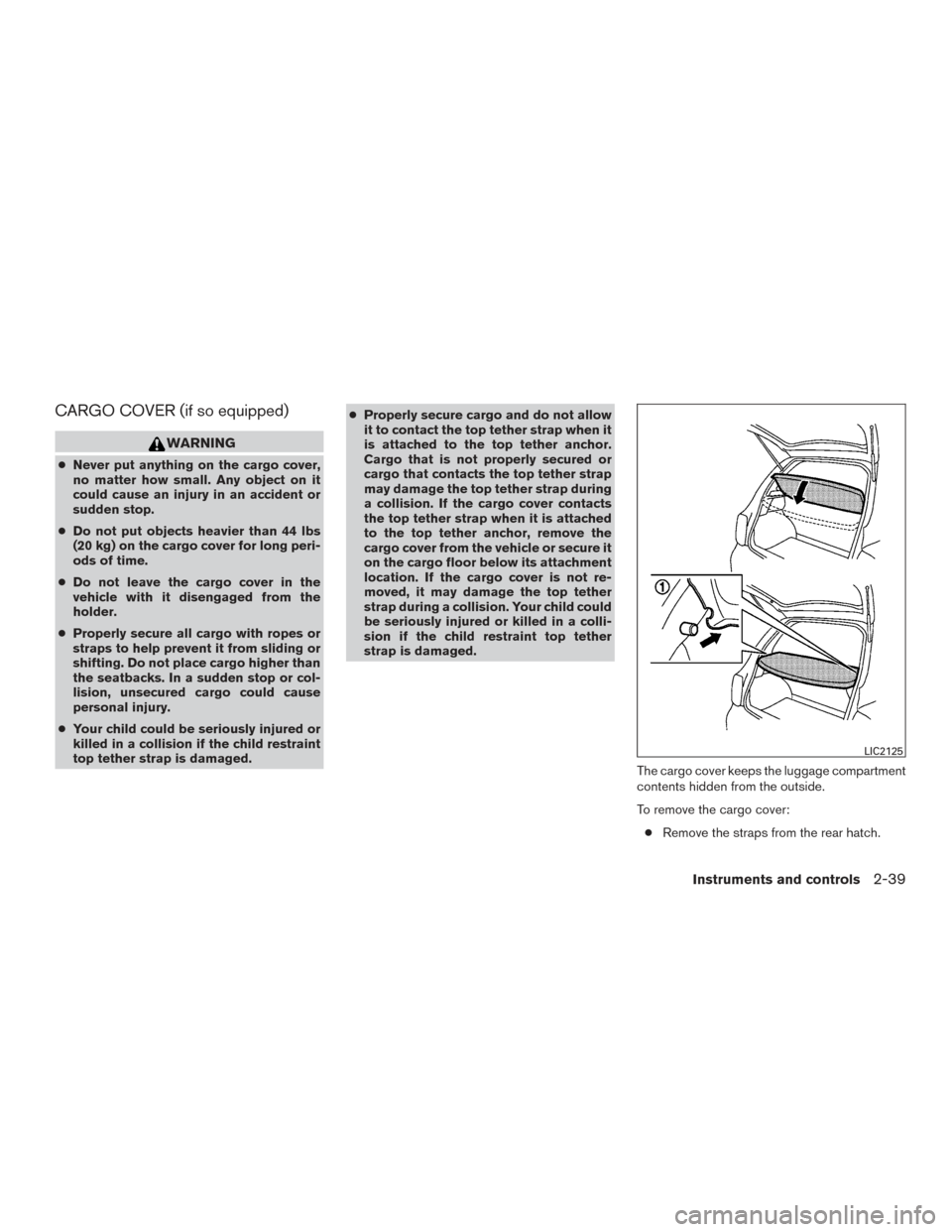
CARGO COVER (if so equipped)
WARNING
●Never put anything on the cargo cover,
no matter how small. Any object on it
could cause an injury in an accident or
sudden stop.
● Do not put objects heavier than 44 lbs
(20 kg) on the cargo cover for long peri-
ods of time.
● Do not leave the cargo cover in the
vehicle with it disengaged from the
holder.
● Properly secure all cargo with ropes or
straps to help prevent it from sliding or
shifting. Do not place cargo higher than
the seatbacks. In a sudden stop or col-
lision, unsecured cargo could cause
personal injury.
● Your child could be seriously injured or
killed in a collision if the child restraint
top tether strap is damaged. ●
Properly secure cargo and do not allow
it to contact the top tether strap when it
is attached to the top tether anchor.
Cargo that is not properly secured or
cargo that contacts the top tether strap
may damage the top tether strap during
a collision. If the cargo cover contacts
the top tether strap when it is attached
to the top tether anchor, remove the
cargo cover from the vehicle or secure it
on the cargo floor below its attachment
location. If the cargo cover is not re-
moved, it may damage the top tether
strap during a collision. Your child could
be seriously injured or killed in a colli-
sion if the child restraint top tether
strap is damaged.
The cargo cover keeps the luggage compartment
contents hidden from the outside.
To remove the cargo cover:● Remove the straps from the rear hatch.
LIC2125
Instruments and controls2-39
Page 407 of 414
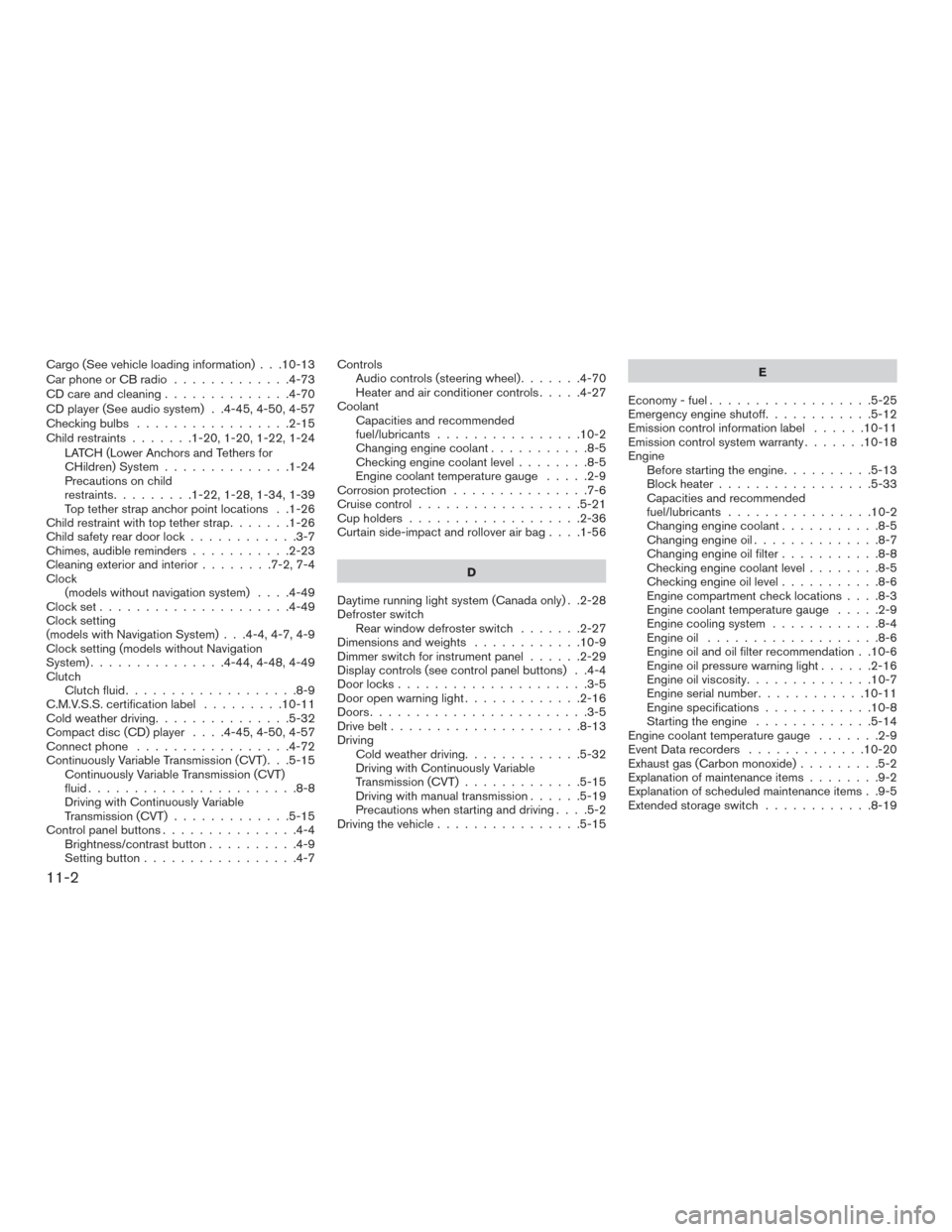
Cargo (See vehicle loading information) . . .10-13
Car phone or CB radio.............4-73
CD care and cleaning ..............4-70
CD player (See audio system) . .4-45, 4-50, 4-57
Checkingbulbs .................2-15
Child restraints .......1-20,1-20,1-22,1-24
LATCH (Lower Anchors and Tethers for
CHildren) System ..............1-24
Precautions on child
restraints.........1-22,1-28,1-34,1-39
Top tether strap anchor point locations . .1-26
Child restraint with top tether strap .......1-26
Child safety rear door lock ............3-7
Chimes, audible reminders ...........2-23
Cleaningexteriorandinterior........7-2,7-4
Clock (models without navigation system) ....4-49
Clockset.....................4-49
Clock setting
(models with Navigation System) . . .4-4, 4-7, 4-9
Clock setting (models without Navigation
System) ...............4-44,4-48,4-49
Clutch Clutch fluid ...................8-9
C.M.V.S.S. certification label .........10-11
Cold weather driving ...............5-32
Compact disc (CD) player ....4-45,4-50,4-57
Connect phone .................4-72
Continuously Variable Transmission (CVT) . . .5-15 Continuously Variable Transmission (CVT)
fluid .......................8-8
Driving with Continuously Variable
Transmission (CVT) .............5-15
Control panel buttons ...............4-4
Brightness/contrast button ..........4-9
Setting button .................4-7 Controls
Audio controls (steering wheel) .......4-70
Heater and air conditioner controls .....4-27
Coolant Capacities and recommended
fuel/lubricants ................10-2
Changingenginecoolant...........8-5
Checking engine coolant level ........8-5
Engine coolant temperature gauge .....2-9
Corrosion protection ...............7-6
Cruisecontrol..................5-21
Cupholders...................2-36
Curtainside-impactandrolloverairbag....1-56
D
Daytime running light system (Canada only) . .2-28
Defroster switch Rear window defroster switch .......2-27
Dimensionsandweights ............10-9
Dimmer switch for instrument panel ......2-29
Display controls (see control panel buttons) . .4-4
Door locks .....................3-5
Door open warning light .............2-16
Doors ........................3-5
Drive belt .....................8-13
Driving Cold weather driving .............5-32
Driving with Continuously Variable
Transmission (CVT) .............5-15
Driving with manual transmission ......5-19
Precautions when starting and driving ....5-2
Driving the vehicle ................5-15 E
Economy-fuel..................5-25
Emergency engine shutoff ............5-12
Emission control information label ......10-11
Emission control system warranty .......10-18
Engine Before starting the engine ..........5-13
Blockheater.................5-33
Capacities and recommended
fuel/lubricants ................10-2
Changing engine coolant ...........8-5
Changingengineoil..............8-7
Changing engine oil filter ...........
8
-8
Checking engine coolant level ........8-5
Checking engine oil level ...........8-6
Engine compartment check locations ....8-3
Engine coolant temperature gauge .....2-9
Engine cooling system ............8-4
Engineoil ...................8-6
Engine oil and oil filter recommendation . .10-6
Engine oil pressure warning light ......2-16
Engine oil viscosity ..............10-7
Engine serial number ............10-11
Engine specifications ............10-8
Starting the engine .............5-14
Engine coolant temperature gauge .......2-9
Event Data recorders .............10-20
Exhaust gas (Carbon monoxide) .........5-2
Explanation of maintenance items ........9-2
Explanation of scheduled maintenance items . .9-5
Extended storage switch ............8-19
11-2
Page 408 of 414
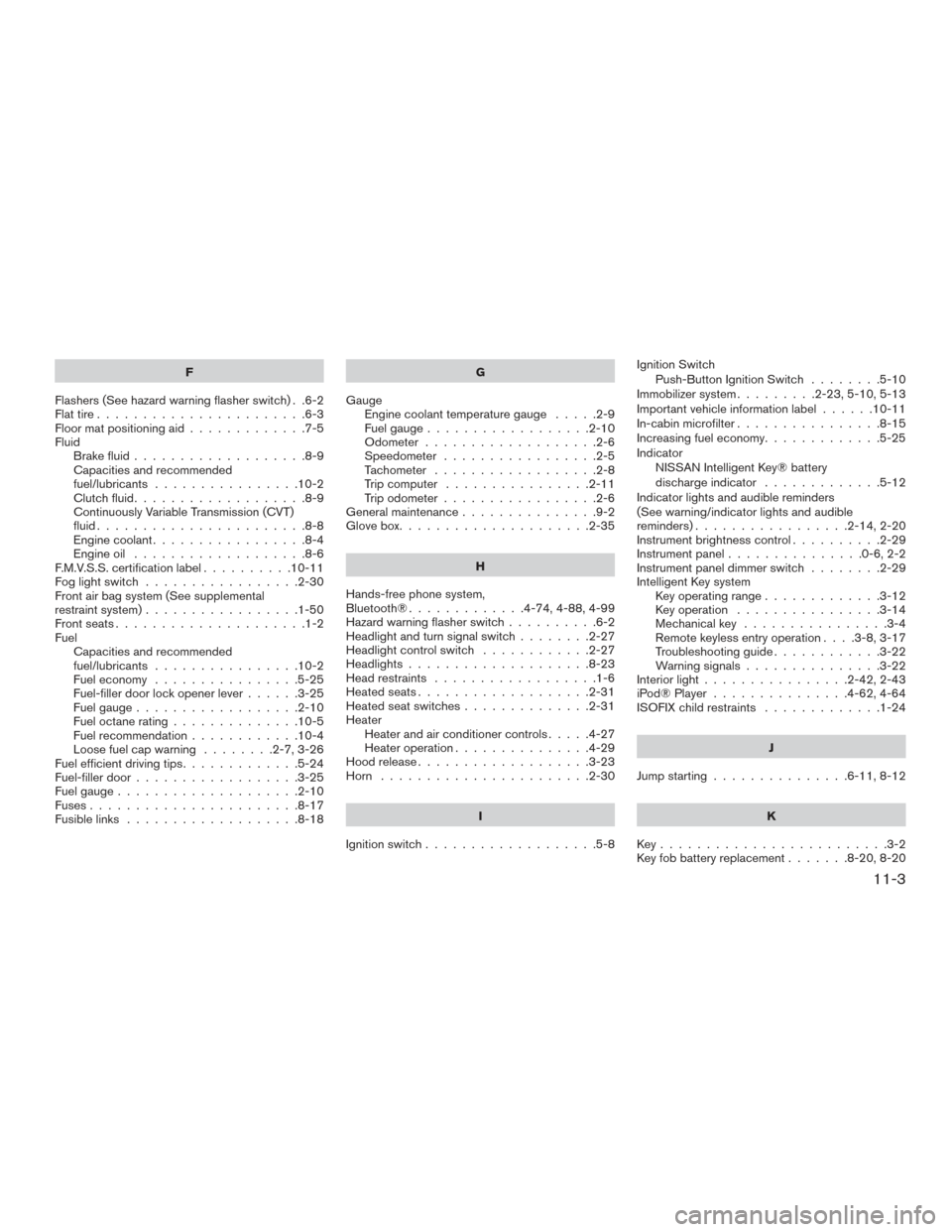
F
Flashers (See hazard warning flasher switch) . .6-2
Flat tire .......................6-3
Floor mat positioning aid .............7-5
Fluid Brake fluid ...................8-9
Capacities and recommended
fuel/lubricants ................10-2
Clutchfluid...................8-9
Continuously Variable Transmission (CVT)
fluid.......................8-8
Engine coolant .................8-4
Engine oil ...................8-6
F.M.V.S.S. certification label ..........10-11
Foglightswitch .................2-30
Front air bag system (See supplemental
restraint system) .................1-50
Frontseats.....................1-2
Fuel Capacities and recommended
fuel/lubricants ................10-2
Fuel economy ................5-25
Fuel-filler door lock opener lever ......3-25
Fuel gauge ..................2-10
Fuel octane rating ..............10-5
Fuel recommendation ............10-4
Loose fuel cap warning ........2-7,3-26
Fuel efficient driving tips .............5-24
Fuel-filler door ..................3-25
Fuel gauge ....................2-10
Fuses.......................8-17
Fusible links ...................8-18 G
Gauge Engine coolant temperature gauge .....2-9
Fuel gauge ..................2-10
Odometer ...................2-6
Speedometer .................2-5
Tachometer ..................2-8
Trip computer ................2-11
Trip odometer .................2-6
General maintenance ...............9-2
Glovebox.....................2-35
H
Hands-free phone system,
Bluetooth®.............4-74,4-88,4-99
Hazard warning flasher switch ..........6-2
Headlight and turn signal switch ........2-27
Headlight control switch ............2-27
Headlights ....................8-23
Head restraints ..................1-6
Heated seats ...................2-31
Heated seat switches ..............2-31
Heater Heater and air conditioner controls .....4-27
Heater operation ...............4-29
Hood release ...................3-23
Horn .......................2-30
I
Ignition switch ...................5-8 Ignition Switch
Push-Button Ignition Switch ........5-10
Immobilizer system .........2-23,5-10,5-13
Important vehicle information label ......10-11
In-cabin microfilter ................8-15
Increasing fuel economy .............5-25
Indicator NISSAN Intelligent Key® battery
discharge indicator .............
5
-12
Indicator lights and audible reminders
(See warning/indicator lights and audible
reminders).................2-14,2-20
Instrument brightness control ..........2-29
Instrumentpanel...............0-6,2-2
Instrument panel dimmer switch ........2-29
Intelligent Key system Key operating range .............3-12
Key operation ................3-14
Mechanical key ................3-4
Remote keyless entry operation ....3-8,3-17
Troubleshooting guide ............3-22
Warning signals ...............3-22
Interior light ................2-42,2-43
iPod®Player ............... 4-62, 4-64
ISOFIX child restraints .............1-24
J
Jump starting ...............6-11,8-12
K
Key.........................3-2
Key fob battery replacement .......8-20,8-20
11-3
Page 410 of 414

Changing engine oil filter...........8-8
Checking engine oil level ...........8-6
Engine oil ...................8-6
Engine oil and oil filter recommendation . .10-6
Engine oil viscosity ..............10-7
Oneshotcall...........4-77,4-90,4-102
Outside mirrors .................3-30
Overheat Ifyourvehicleoverheats...........6-13
Owner’s manual order form ..........10-21
Owner’s manual/service manual order
information ...................10-21
P
Parking Parking brake operation ...........5-20
Parking/parking on hills ...........5-26
Parking brake ...................5-20
Phone, Bluetooth® hands-free
system ...............4-74,4-88,4-99
Power Power door locks ...............3-6
Power outlet .................2-33
Power rear windows .............2-41
Power steering system ...........5-27
Power windows ...............2-40
Rear power windows ............2-41
Power outlet ...................2-33
Power steering ..................5-27
Precautions Maintenance precautions ...........8-2
Precautions on booster
seats...........1-22,1-28,1-34,1-39 Precautions on child
restraints
.........1-22,1-28,1-34,1-39
Precautions on seat belt usage .......1-10
Precautions on supplemental restraint
system ....................1-42
Precautions when starting and driving ....5-2
Programmablefeatures..............4-7
Push starting ...................6-13
R
Radio Car phone or CB radio ...........4-73
FM-AM radio with compact disc (CD)
player .....................4-43
FM/AM/SAT radio with compact disc (CD)
player .................4-47,4-52
Steering wheel audio control switch ....4-70
Readiness for inspection maintenance (I/M)
test .......................10-20
Rear center seat belt ..............1-16
Rear power windows ..............2-41
Rearseat......................1-4
Rearview mirror .................3-29
RearView Monitor ................4-10
Rear window defroster switch .........2-27
Rear window wiper and washer switches . . .2-26
Recommended Fluids ..............10-2
Recorders EventData .................10-20
Refrigerant recommendation ..........10-7
Registering a vehicle in another country . . .10-10
Reporting safety defects (US only) ......10-19 S
Safety Child safety rear door lock ..........3-7
Child seat belts .....1-22,1-28,1-34,1-39
Reporting safety defects (US only) ....10-19
Seat adjustment Front manual seat adjustment ........1-3
Rear seat adjustment .............1-4
Seatbackpockets................2-34
Seat belt Child safety ..................1-20
Infants and
small children ..........1-20
Injured Person ................1-13
Largerchildren................1-21
Precautions on seat belt usage .......1-10
Pregnant women ...............1-13
Rear center seat belt ............1-16
Seatbeltextenders .............1-19
Seatbeltmaintenance............1-19
Seatbelts................1-10,7-6
Shoulder belt height adjustment ......1-18
Three-point type with retractor .......1-13
Seat belt extenders ...............1-19
Seatbeltwarninglight..........1-13,2-19
Seats Adjustment ...................1-2
Armrests....................1-5
Frontseats...................1-2
Heatedseats.................2-31
Manualfrontseatadjustment.........1-3
Rearseat....................1-4
Security indicator light ..............2-22
Security system (NISSAN Vehicle Immobilizer
System) , engine start .......2-23,5-10,5-13
11-5